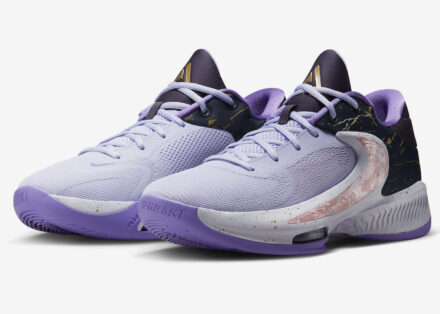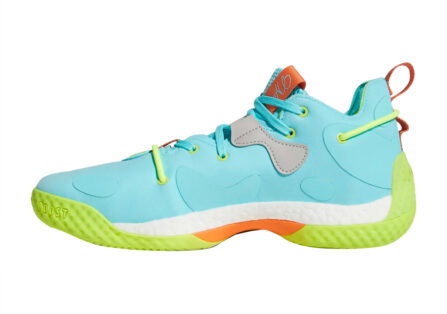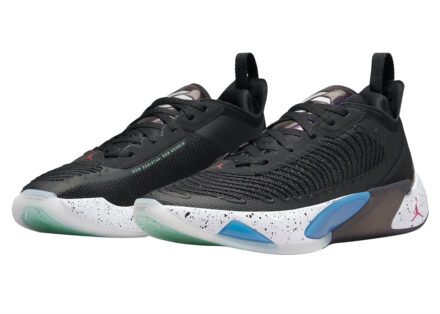
With the exception of his most recent Gilas Pilipinas stint and his short-lived NCAA Division I exploits, Kobe Paras has always been the go-to guy.
That changes the moment he puts on a Niigata Albirex jersey, as he will be playing alongside a trio of imports who have experience top-scoring for a B.League club: former NBA player Jeff Ayres, Stanford University standout Rosco Allen, and longtime Japan import Tshilidzi Nephawe. Suffice to say, Paras probably won’t see his name called every possession down the floor.
In this piece, we’re here to reimagine Paras not as the high-flying, rim-attacking, ball-dominant Fighting Maroon, but as the quality player he will be in Japan playing alongside talented big men.
Attacking the Rim
We already know Paras can jump with the best of them — YouTube is littered with hundreds of videos of him throwing it down. He’s 6’6 with a good, if not great, vertical leap. To add to this, he has a strong frame that allows him to absorb contact to finish and to draw fouls. His 35.7% free throw attempt rate in the UAAP would place him in the top 30% of players since Season 77. With a clear lane to the rim, defenders were usually overmatched and resorted to simply fouling to prevent him from scoring.
Playing with better players in Japan won’t stop him from being a transition threat, as his combination of athletic traits will always make defenders wary in that situation. As a slasher, Paras’ primary weapon is his ability to convert on straight line drives. These opportunities will be less than what he’s used to while he played in UP, but these drives will make up the bulk of his halfcourt touches. As long as the floor is spaced well, Paras can and will take advantage of driving lanes where there is little resistance.
The biggest adjustments will come in his shot selection. Paras tended to put up shots that could only be described as bad. His role on the Maroons, his wiring, and his perception of his abilities all contribute to his shooting decision-making process. These bad shots happened in bulk and made a hit on Paras’ shooting efficiency.
He’s a 6’6 forward that outclassed almost every UAAP player in terms of both athleticism and physique. His playstyle is geared around getting shots at the rim where only few individuals can challenge him. Yet he found himself three percentage points below league average in terms of true shooting percentage (TS%). Defenses walled Paras in when he drove, as the threat of him scoring required teams to give him a ton of attention, but in the end, he failed to take advantage of the attention to create for his teammates. There was a tendency for him to take on multiple defenders either early in the shot clock before his teammates were ready (and therefore, without passing valves), or in normal situations where he just decided to shoot over two or three defenders instead of kicking it out to an open man.
His percentages weren’t really an issue of touch around the rim. He doesn’t have an immaculate or feathery touch, but it’s nowhere near bad. He can comfortably hit floaters from five feet out without any worries consistently, and he uses this to beat rim protectors when he chooses not to go all the way to the cup. Paras is pretty ambidextrous headed towards the rim and he’s capable of finishing with either hand. He was one of the better off hand finishers in the UAAP in Season 82.
Ball handling is where it gets tricky for Paras. Barring a tremendous improvement between Season 82 to the present, he doesn’t possess the chops to be relied on as an initiator in the professional setting. He showcases great agility and change of direction upon picking the ball up, but prior to that, there are problems.
He doesn’t really rely on dribbling moves to create space or blow by people. Instead, he uses his body to create bits of separation. He isn’t comfortable handling the ball in tight spaces, and this results in him picking the ball up — or worse, turning it over. He doesn’t have the best control of the basketball in-game and can commit errors when performing dribble moves. He doesn’t have a wide array of dribble moves at his disposal. Beyond straight line drives, Paras has a pretty decent behind the back dribble that he goes to a lot, but not a lot to fall back on.
Ball handling is probably the toughest individual skill to improve. It requires a ton of in-game repetitions to build up. Only one player is allowed to dribble at the time. If you aren’t good at it, chances are you won’t get too many opportunities to improve. Due to his lack of polish in this area, there is a possibility that Paras might not get too many reps handling the ball in Japan.
Still, there are ways for him to be productive despite this.
Paras doesn’t really need the ball in his hands to score. He was a devastating cutter in the UAAP, and there is no reason for him not to be one in Japan. He has a great sense of timing; he knows when to make the cut and take advantage of the shape of a defense to create scoring opportunities for himself. Paras mixes in feints and changes of direction to create an extra bit of space to widen the passing window and to make his shots a bit easier. His size and athleticism is used to a devastating effect when he takes advantage of his off-ball prowess.
Furthermore, he displayed great chemistry with big man Bright Akhuetie and used his low post playmaking to create easy shots for him under the rim. Ideally, he should be able to replicate the same with Ayres and Allen, who are both decent passing bigs who have posted double digit assist percentages in Japan.
OUTSIDE SHOOTING
Paras has spent a lot of his time sharpening his jumper, but without meaningful games there isn’t a way for us to know if he has improved. In the UAAP, he was a terrible shooter from deep (21.6 3P% on 5.3 attempts per game), but was an above average shooter from the FT line (69.1% compared to the 63.9% league average). He can succeed in Japan without a huge improvement in his jumper, but obviously, a better shot won’t hurt him.
His touch from both the line and near the rim might be indicators of shooting potential, but he was largely ineffective when we saw him last in the Asia Cup Qualifiers as well. However, there is a glimmer of shooting potential once we check the tape. He can hit catch-and-shoot triples at a decent enough rate. With a few tweaks in his form, there is no reason to believe that he can’t be decent in this respect.
The biggest problem in his shot (beyond his form) is his tendency to rush shots when contested. When there is a nearby defender, he rushes his shot mechanics and doesn’t achieve elbow lock (extending your elbow to its natural maximum length) during the release. This causes inconsistency in his shot; elbow lock is a natural limit, which means that if you achieve it, your arm is extending to the same length every time. Given his height, there should be little that any non-big in the UAAP could do to bother his shot. But that wasn’t the case on film, as his shot deteriorated to a great degree when contested. This problem pulled his percentages to putrid levels.
Passing
Paras’ ability to connect plays is what gives him value at the professional level. His passing is really underrated, and it’s a skill that’s overshadowed by the more eye-catching aspects of his game.
From a standstill, he exhibits quality court vision and is capable of making high leverage passes that result in easy layups for his teammates. He doesn’t necessarily create the advantageous situations, but he is able to put the ball in the right spots to take advantageous situations and convert them into points.
However, this is not to say that he is an excellent passer. The intersection of his poor ball handling and his occasional tunnel vision lead to less than accurate passes on the move. To his credit, he often incorporates a bit of misdirection in his kickout passes; he holds the defense in place with both his drive and his eyes looking to one side of the floor while choosing to pass to open space. But he tends to overdo this, and that could contribute to the inaccuracy. However, a little bit of experience could go a long way for Paras.
Defense
There’s little doubt that Paras can contribute on the defensive end of the floor. He’s a versatile defender who managed to defend almost every position in spurts in the UAAP, and he was probably the most important player in the Maroons’ defensive scheme. He served as the best rim protector on the team given Akhuetie’s vertical limitations, and he was also second on the team in steal percentage. He was an active event creator on defense and was one of the lone plus spots for a Fighting Maroons team that bannered the third-worst defensive team in the UAAP.
The biggest problem with Paras on defense is his tendency to swipe, gamble, and bite. In the same manner he looks for the highlight play on offense, he looks for the home run play on defense. The second clip in the video below best illustrates the problem. He would go for the steal, interception, or block instead of making the safe defensive play. He didn’t do this all the time, but he did it enough for it to be a bit troubling. He can tend to swipe on the perimeter (especially after being caught flat-footed) and this allows his man to blow by him. When he gambles, he sometimes ends up winning, but he could still do well to improve his ability to discern when the right time to strike is.
Now on to the positives. First off: Paras is a better screen navigator than most guards in the UAAP. He makes himself skinny and doesn’t die on screens often. He fights and chases really well and this will translate in the pros. He plays excellent denial defense and will fight to prevent his man from getting the ball if it’s asked of him. He used his terrific combination of strength, size, and athleticism to stay in front of his man, bother shots, and even prevent shots from being thrown up.
Paras is a pretty strong guy. He was able to guard Soulemane Chabi Yo well enough in the post whenever UP faced UST. This is proof of his potential to be a versatile player in the pros who could feasibly guard the 2-4. With a strong lower body, he is able to minimize the amount of ground he gives up to strong players inside and force a more difficult shot. However, he doesn’t jump a lot when defending in the post (perhaps to avoid fouls), which might make him easy pickings for a big with a good turnaround fade or hook.
His potential to be a secondary rim protector is very enticing. Among locals, his 3.5 block percentage only lagged behind Ateneo’s Will Navarro, UST’s Rhenz Abando, and Adamson’s Simon Camacho. This is notable considering that he isn’t a natural rim protector. His first instinct when meeting slashers is to swipe at the ball instead of contesting at the rim, which makes it less likely for him to block shots. He is also not the quickest to react and rotate when breakdowns occur. If he is able to correct these problems, it would be a very dangerous proposition to challenge Paras at the rim (unless of course, you’re taller, stronger, or more athletic than him). When he gets his rotations right, his ability to explode quickly off of two feet allows him to protect the rim by either contesting, blocking, altering, or outright dissuading shots.
Overview
Niigata probably won’t be getting the Kobe Paras who scored 16.1 points per game on 16.2 shot attempts, but it is for the best. Paras has the skills to thrive on offense without having the game plan being centered on him creating his own opportunities. He can attack tilted defenses with straight line drives, move off-ball for easy shots at the rim, and connect and complete advantages created by his teammates. That Paras provides legitimate value on offense and would be a welcome addition to any Japanese professional team. On defense, Paras offers a ton of value in his versatility inside and outside. He can mark his man on and off the ball and step up to protect the rim in a pinch. Niigata should consider themselves lucky to receive the services of one of the more versatile talents that the Philippines has to offer.
Advanced Stats are now available for Philippine basketball! Through Ryan Alba’s ‘Stats by Ryan’, you can now look at team and player advanced stats for the current 2021 PBA Philippine Cup (and the previous three seasons) via the Dribble Media website.
Check out this glossary for a list of the basketball advanced stats terminologies.
You can also contact Ryan via his Twitter handle (@_alba__).






1 thought on “The Japan Chronicles: Reimagining the Best Version of Kobe Paras”
You did an awesome job breaking down Kobe’s playing style and tendencies! I do hope he reads this as this would help him make improvements on his game and continue to be better. Kudos! UP Fight!